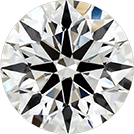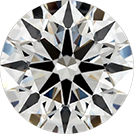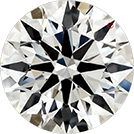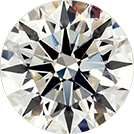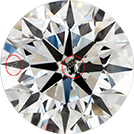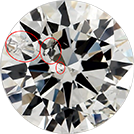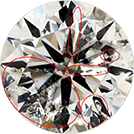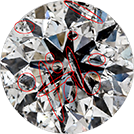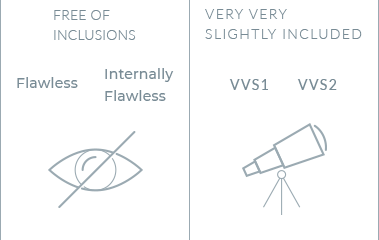GIA Clarity Grading Scale

Ok, now you might be looking at the clarity scale thinking, "what do all those letters and numbers mean???" Don't worry. It just looks complicated, confusing, and boring. I can guarantee you that after a few minutes, you will not think this way anymore.
The scale is rather simple, it starts from the highest clarity grade FL (Flawless), and it ends with the lowest grade of I3. The higher the clarity grade is – the rarer and the higher the price of the diamond.
Flawless
Internally Flawless
Flawless
VVS1
VVS2
Very Very Slightly Included
VS1
VS2
Very Slightly Included
SI1
SI2
Slightly Included
I1
I2
I3
Included


Flawless
At the top of the scale, there are FL – Flawless and IF – Internally Flawless diamonds. Both those grades have no visible inclusions that can be detected by an experienced gemologist using 10X magnification. They are extremely rare and, therefore, very expensive.
The price: The most expensive.
It doesn't matter if you look for internal inclusions with the naked eye or by ten times magnification; you will find nothing at all. The diamond is absolutely clear.


Very Very Slightly Included
The next category of clarity is VVS (Very Very Slightly included). VVS diamonds contain microscopic inclusions that take time and effort to detect, even for a very experienced gemologist using a microscope. They are almost impossible to detect using a standard 10X magnification loupe. In other words, as a gemologist, I can tell you a small secret: neither you nor your girlfriend, not even the most professional jeweler you may find, or a seller in a fancy jewelry store can see the differences between FL, IF, VVS1 or VVS2 diamonds. Only a high skilled gemologist can do it using a special gemological microscope. In 100% of cases, a professional gemologist will refuse to grade the clarity of Fl to VVS2 diamonds without the microscope.
The price: Too expensive.
If you consider buying VVS2 when you want Flawless, don't hesitate to go for it. Your girlfriend will not be able to see the difference. Actually, nobody will.


Very Slightly included
The next category is VS (Very Slightly included). VS diamonds contain tiny inclusions that are not visible to the naked eye. It even takes a while to detect such inclusions under 10X magnification for a professional. A non-professional will not be able to see VS inclusions with the naked eye, and even under proper magnification, it would still be almost impossible.
The price: Very high.
Even by ten times magnification, your chance to find an inclusion is close to zero.


Slightly included
The next category is SI (Slightly Included diamonds). This is the most popular category among buyers. In most cases, SI diamonds are eye clean diamonds when observed with the naked eye. But, inclusions are easily detected under 10X magnification. SI diamonds are considered the best choice for those looking for an eye-clean diamond at a low price. A non-professional will not be able to see VS inclusions with the naked eye, but he can find it by ten times magnification.
The price: Expensive.
You will have to use the loupe to detect an inclusion. Without the loupe, it is impossible.


included I1
The next category is I (Included). Here inclusions are evident to the naked eye. Should you ignore this category? Not at all. First, let's divide it into two parts: I1 and I2-I3. What about I1 diamonds? Well, most of those diamonds contain visible inclusions easily detected by the naked eye. Still, some of them are only visible under a gemological laboratory's proper lighting conditions and almost invisible under regular lighting. An experienced gemologist can help you find such an I1 diamond that will look much better than the I1 grade. It can help you to save money and still to get an excellent stone for your fiancé.
The price: It's not so high, but it is still expensive.
You will have to look closely to find an inclusion without the loupe.


included I2 I3
As a gemologist, I wouldn't recommend you purchase I2 and I3 diamonds since they contain visible inclusions capturing 20% and more of the diamond.
I2 and I3.. don't even think to approach such clarity if you don't want to get a divorce even before you get married.

In Conclusion
You may ask, what is the difference between 1 and 2 clarity grades, like VS1 and VS2, SI1 and SL2, etc. To make it an easy way. We'll cut all nuances, border cases and will talk about the most common definitions.
- VVS1single microscopic inclusion
- VVS2few microscopic inclusions
- VS1inclusions are difficult to detect, mostly far from the center of the diamond.
- VS2inclusions are difficult to detect, close to the center of the stone.
- SI1easily detected inclusions by x10 times magnification, small quantity, small in size, or far from the center.
- SI2easily detected inclusions by x10 times magnification, bigger number, a bigger size, or in the center of the stone.
- I1eye visible inclusions take up to 20% of the surface of the stone.
- I2eye visible inclusions take 20 to 60% of the surface of the stone.
- I3what is the difference? Who cares? It doesn't matter. You don't want it anyway.)
I hope this article helped you to understand the clarity scale better. If you have any questions, don't hesitate, share your concerns with us, and we will help you find the best stone for your beloved.
Learn more about diamonds

